A Review on Energy and Renewable Energy Policies in Iran
Abstract
:1. Introduction
2. Research Method
Econometric Model
3. Current Energy Supply
3.1. General Overview
3.2. Crude Oil
3.3. Natural Gas
3.4. Coal
3.5. Wind Enrgy
3.6. Hydroelectric Energy
4. Renewable Energy Sources
4.1. Energy Diversity Policy and Other Energy Policies
4.2. Small-Scale Hydropower
4.3. Solar Energy
4.4. Biomass
4.5. Biofuels
4.6. Geothermal
5. Econometric Results
6. Conclusions
Funding
Institutional Review Board Statement
Informed Consent Statement
Data Availability Statement
Conflicts of Interest
Appendix A
| LGDP (IRR Billion) | LLF (1000 People) | LGFKF (USD Million) | LNREN (ktoe) | LREN (ktoe) | |
|---|---|---|---|---|---|
| Mean | 15.09776 | 9.492841 | 10.74469 | 10.78031 | 7.042203 |
| Median | 15.02835 | 9.493683 | 10.88931 | 10.95113 | 6.900351 |
| Maximum | 15.75293 | 10.0981 | 11.84446 | 12.04142 | 8.356657 |
| Minimum | 14.19673 | 8.824737 | 9.019639 | 8.690626 | 6.365443 |
| Std. Dev. | 0.392414 | 0.41071 | 0.739127 | 0.97287 | 0.525495 |
| Variable | Dickey Fuller GLS | Phillips–Perron | Augmented Dickey Fuller | |||
|---|---|---|---|---|---|---|
| Level | First Difference | Level | First Difference | Level | First Difference | |
| LGDP | 0.104 | −5.098 * | −0.558 | −5.098 * | −0.743 | −5.071 * |
| LLF | 0.430 | −2.433 ** | 0.759 | −4.497 * | 0.170 | −2.601 *** |
| LGFKF | 0.987 | −6.103 * | −0.044 | −6.012 * | 0.110 | −6.054 * |
| LNREN | 0.849 | −2.451 * | 2.456 | −5.496 * | 3.006 | −2.686 *** |
| LREN | -0.467 | −6.194 * | 0.020 | −5.151 * | −0.473 | −6.174 * |
References
- Mohammadi, V.; Mozaffari Shamsi, H.; Asadi, F. Investigating the relationship between economic growth, energy consumption and human development in selected MENA countries (MENA). Iran. J. Energy Econ. 2019, 8, 811–850. [Google Scholar]
- Ministry of Energy. Energy Balance 2017; Ministry of Energy: Tehran, Iran, 2020.
- Mozayani, A.H.; Essari Arani, A.; Afsharian, B.; Rasouli, A. Redefinition of the Relation between Energy Consumption and Economic Growth in Iran: Markov Switching Approach. Econ. Modeling 2015, 9, 67–89. [Google Scholar]
- Cheratian, I.; Goltabar, S. Energy Consumption and Regional Economic Growth: The Case of Iranian Manufacturing Sector; MPRA Paper 78315; University Library of Munich: Munich, Germany, 2017. [Google Scholar]
- Abdouli, M.; Hammami, S. Exploring links between FDI inflows, energy consumption, and economic growth: Further evidence from MENA countries. J. Econ. Dev. 2017, 42, 95–117. [Google Scholar] [CrossRef]
- Mirzaei, M.; Bekri, M. Energy consumption and CO2 emissions in Iran, 2025. Environ. Res. 2017, 154, 345–351. [Google Scholar] [CrossRef] [PubMed]
- Ghaseminejad, A.A.; Hosseini, S.; Moghaddasi, R. How energy consumption is related to agricultural growth and export: An econometric analysis on Iranian data. Energy Rep. 2019, 5, 50–53. [Google Scholar]
- Aghaei, M.; Lawell, C.Y.C.L. Energy, economic growth, inequality, and poverty in Iran. Singap. Econ. Rev. 2020. [Google Scholar] [CrossRef]
- Tugcu, C.T.; Topcu, M. Total, renewable and non-renewable energy consumption and economic growth: Revisiting the issue with an asymmetric point of view. Energy 2018, 152, 64–74. [Google Scholar] [CrossRef]
- Rahman, M.M.; Velayutham, E. Renewable and non-renewable energy consumption-economic growth nexus: New evidence from South Asia. Renew. Energy 2020, 147, 399–408. [Google Scholar] [CrossRef]
- Sunde, T. Energy consumption and economic growth modelling in SADC countries: An application of the VAR Granger causality analysis. Int. J. Energy Technol. Policy 2020, 16, 41–56. [Google Scholar] [CrossRef]
- Aydin, M. Natural gas consumption and economic growth nexus for top 10 natural Gas–Consuming countries: A granger causality analysis in the frequency domain. Energy 2018, 165, 179–186. [Google Scholar] [CrossRef]
- Rahman, M.M.; Abul Kashem, M. Carbon emissions, energy consumption and industrial growth in Bangladesh: Empirical evidence from ARDL cointegration and Granger causality analysis. Energy Policy 2017, 110, 600–608. [Google Scholar] [CrossRef]
- Akadiri, S.S.; Lasisi, T.T.; Uzuner, G.; Akadiri, A.C. Examining the causal impacts of tourism, globalization, economic growth and carbon emissions in tourism island territories: Bootstrap panel Granger causality analysis. Curr. Issues Tour. 2020, 23, 470–484. [Google Scholar] [CrossRef]
- Al-Mulali, U.; Solarin, S.A.; Ozturk, I. Biofuel energy consumption-economic growth relationship: An empirical investigation of Brazil. Biofuels Bio-Prod. Biorefining 2016, 10, 753–775. [Google Scholar] [CrossRef]
- Engle, R.F.; Granger, C.W.J. Co-integration and error correction: Representation, estimation, and testing. J. Econom. 1987, 55, 251–276. [Google Scholar] [CrossRef]
- Mollahosseinia, A.; Hosseinib, S.A.; Jabbaric, M.; Figolid, A.; Rahimpour, A. Renewable energy management and market in Iran: A holistic review on current state and future demands. Renew. Sustain. Energy Rev. 2017, 88, 774–788. [Google Scholar] [CrossRef]
- Alamdari, P.; Mirhosseini, O.N.M. Assessment of wind energy in Iran: A review. Renew. Sustain. Energy Rev. 2012, 16, 836–860. [Google Scholar] [CrossRef]
- Najafi, G.; Ghobadian, B.; Mamat, B.; Yusaf, T.; Azmi, W.H. Solar energy in Iran: Current state and outlook. Renew. Sustain. Energy Rev. 2015, 49, 931–942. [Google Scholar] [CrossRef] [Green Version]
- Ghasemi, A.; Taklif, A.; Mohammadi, T.; Mohammadian, F. Analysis of Iran’s energy strategies on the horizon of 2041 in the framework of global energy scenarios. Iran. J. Energy Econ. 2017, 6, 121–189. [Google Scholar]
- Central Bank of Iran. National Accounts; Central Bank of Iran: Tehran, Iran, 2020. [Google Scholar]
- Vice President of Legal Affairs. Resolution of the High Energy Council Regarding the National Document of the Country’s Energy Strategy; Vice President of Legal Affairs: Tehran, Iran, 2016. [Google Scholar]
- Ghaedizadeh, N.; Khalili Dizaji, H. Status of Iran’s Common Oil and Gas Reservoirs from the Perspective of International Law. Mon. Oil Gas Explor. Prod. 2014, 110, 3–8. [Google Scholar]
- National Iranian Oil Company. Supply of 6 Million Barrels of Crude Oil and Gas Condensate in the Energy Exchange; National Iranian Oil Company: Tehran, Iran, 2019; Available online: https://www.nioc.ir/portal/home/?news/100193/359783/360628/ (accessed on 25 June 2021).
- Dudlák, T. After the sanctions: Policy challenges in transition to a new political economy of the Iranian oil and gas sectors. Energy Policy 2018, 121, 464–475. [Google Scholar] [CrossRef] [Green Version]
- Ministry of Energy. Energy Statistics and Charts of Iran and the World 2017; Ministry of Energy: Tehran, Iran, 2020.
- Ministry of Energy. An Overview of 30 Years of the Country’s Energy Statistics; Ministry of Energy: Tehran, Iran, 2020.
- Ministry of Energy. Time Series for Iran’s Energy Balances; Ministry of Energy: Tehran, Iran, 2020.
- Rezaei, T.; Takif, A.; Ghasemi, A. Feasibility study of gas hub formation using SWOT approach. Iran. J. Energy Econ. 2018, 8, 69–102. [Google Scholar]
- Sadik-Zada, E.R.; Gatto, A. Energy Security Pathways in South East Europe: Diversification of the Natural Gas Supplies, Energy Transition, and Energy Futures. In From Economic to Energy Transition. Energy, Climate and the Environment; Mišík, M., Oravcová, V., Eds.; Palgrave Macmillan: Cham, Switzerland, 2021. [Google Scholar] [CrossRef]
- Hafezi, R.; Akhavan, A.N.; Pakseresht, S. Projecting plausible futures for Iranian oil and gas industries: Analyzing of historical strategies. J. Nat. Gas Sci. Eng. 2017, 39, 15–27. [Google Scholar] [CrossRef]
- Azadi, P.; Nezam Sarmadi, A.; Shirvani, T. The Outlook for Natural Gas, Electricity, and Renewable Energy in Iran; The Stanford Iran 2040 Project, Working Paper No. 3; Stanford University: Stanford, CA, USA, 2017. [Google Scholar]
- Renewable Energy and Energy Efficiency Organization (SATBA). Annual Report on Renewable Energy and Employment-2018; SATBA: Tehran, Iran, 2020.
- Pishgar-Komleh, S.H.; Akram, A. Evaluation of wind energy potential for different turbine models based on the wind speed data of Zabol region, Iran. Sustain. Energy Technol. Assess. 2017, 22, 34–40. [Google Scholar] [CrossRef]
- Fazelpour, F.; Markarian, E.; Soltani, N. Wind energy potential and economic assessment of four locations in Sistan and Balouchestan province in Iran. Renew. Energy 2017, 109, 646–667. [Google Scholar] [CrossRef]
- Aryanpur, V.; Atabaki, M.S.; Marzband, M.; Siano, M.P.; Ghayoumi, K. An overview of energy planning in Iran and transition pathways towards sustainable electricity supply sector. Renew. Sustain. Energy Rev. 2019, 112, 58–74. [Google Scholar] [CrossRef]
- Najafi, G.; Ghobadian, B. LLK1694-wind energy resources and development in Iran. Renew. Sustain. Energy Rev. 2011, 15, 2719–2728. [Google Scholar] [CrossRef]
- Global Wind Energy Council. Annual Global Wind Report (2019); Global Wind Energy Council: Brussels, Belgium, 2020. [Google Scholar]
- Razavieh, A.; Sedaghat, A.; Ayodele, R.; Mostafaeipour, A. Worldwide wind energy status and the characteristics of wind energy in Iran, case study: The province of Sistan and Baluchestan. Int. J. Sustain. Energy 2017, 36, 103–123. [Google Scholar] [CrossRef]
- Skandari Shabani, S.; Maki, S.V. Hydropower plants. In Proceedings of the 3rd International Conference on Science and Engineering, Istanbul, Turkey, 2 June 2016; Available online: https://civilica.com/doc/491476 (accessed on 25 June 2021).
- Manzoor, D.; Rahimi, A. Prioritization of power plants in Iran using multidisciplinary decision models. Iran. J. Energy Econ. 2015, 4, 191–215. [Google Scholar]
- Rezaei, R.; Ghofranfarid, M. Rural households’ renewable energy usage intention in Iran: Extending the unified theory of acceptance and use of technology. Renew. Energy 2018, 122, 382–391. [Google Scholar] [CrossRef]
- Jahangoshai Rezaee, M.; Yousefi, S.; Hayati, J. Root barriers management in development of renewable energy resources in Iran: An interpretative structural modeling approach. Energy Policy 2019, 129, 292–306. [Google Scholar] [CrossRef]
- Pirasteh, G.; Ashrafizadeh, A.; Salehi Dezfuli, M.M. Energy policies and their impact on the development of renewable energy. In Proceedings of the Fifth Conference on Renewable, Clean and Efficient Energy, Tehran, Iran, 6 March 2013. [Google Scholar]
- Mistry of Energy. General Policies, Country’s General Policies; Mistry of Energy: Tehran, Iran, 2000.
- Solaymani, S. A CO2 Emissions Assessment of the Green Economy in Iran. Greenh. Gases Sci. Technol. 2020, 10, 390–407. [Google Scholar] [CrossRef]
- Aghahosseini, A.; Bogdanov, D.; Ghorbani, N.; Breyer, C. Analysis of 100% renewable energy for Iran in 2030: Integrating solar PV, wind energy and storage. Int. J. Environ. Sci. Technol. 2018, 15, 17–36. [Google Scholar] [CrossRef]
- Torabi, G.; Khoshnavaz, M.; Safari Karchani, A.; Ghadimi, A.A. Potential Assessment and Identification of Potential Points for Installation of Very Small Hydropower Plants in Lorestan Province; Niroo Research Institute: Tehran, Iran, 2009. [Google Scholar]
- Hajighafouri Bukani, N. Investigation of hydropower plants in Iran and some countries of the world. Mech. Eng. 2015, 103, 36–46. [Google Scholar]
- Sovacool, B.K.; Walter, G. Major hydropower states, sustainable development, and energy security: Insights from a preliminary cross-comparative assessment. Energy 2018, 142, 1074–1082. [Google Scholar] [CrossRef] [Green Version]
- Shahsavari, A.; Yazdi, F.T.; Yazdi, H.T. Potential of solar energy in Iran for carbon dioxide mitigation. Int. J. Environ. Sci. Technol. 2019, 16, 507–524. [Google Scholar] [CrossRef]
- Dehghan, A.A. Status and potentials of renewable energies in Yazd Province-Iran. Renew. Sustain. Energy Rev. 2011, 15, 1491–1496. [Google Scholar] [CrossRef]
- Sharbafian, N. Estimation of Technical and Economic Potential of Thermal Solar Energy in Iran: A Strategy for Sustainable Development of Solar Energy. Energy Econ. Stud. 2007, 4, 35–53. [Google Scholar]
- Gorgani Firouzjah, K. Assessment of small-scale solar PV systems in Iran: Regions priority, potentials and financial feasibility. Renew. Sustain. Energy Rev. 2018, 94, 267–274. [Google Scholar] [CrossRef]
- Sansaniwal, S.K.; Sharma, V.; Mathur, J. Energy and exergy analyses of various typical solar energy applications: A comprehensive review. Renew. Sustain. Energy Rev. 2018, 82, 1576–1601. [Google Scholar] [CrossRef]
- Badran, O.O. Study in industrial applications of solar energy and the range of its utilization in Jordan. Renew. Energy 2001, 24, 485–490. [Google Scholar] [CrossRef]
- Gorjian, S.; Zadeh, B.N.; Eltrop, L.; Shamshiri, R.R.; Amanlou, Y. Solar photovoltaic power generation in Iran: Development, policies, and barriers. Renew. Sustain. Energy Rev. 2019, 106, 110–123. [Google Scholar] [CrossRef]
- Edalati, E.; Ameri, M.; Iranmanesh, M.; Sadeghi, Z. Solar photovoltaic power plants in five top oil-producing countries in Middle East: A case study in Iran. Renew. Sustain. Energy Rev. 2017, 69, 1271–1280. [Google Scholar] [CrossRef]
- Wyman, C.E.; Goodman, B.J. Biotechnology for production of fuels, chemicals, and materials from biomass. Appl. Biochem. Biotechnol. 1993, 39, 41. [Google Scholar] [CrossRef]
- SATBA. Report 4: Biomass Energy 1; SATBA: Tehran, Iran, 2005. Available online: http://www.dres-isf.ir/home/phocadownload/%D8%B2%DB%8C%D8%B3%D8%AA%20%D8%AA%D9%88%D8%AF%D9%87.pdf (accessed on 25 June 2021).
- Ministry of Agriculture Jihad. Annual Report 2019; Ministry of Agriculture Jihad: Tehran, Iran, 2019.
- Mohammadi Moghanaki, M.; Ghobadian, B.; Janzadeh Gulogah, R.; Najafi, G.H. Feasibility study of the use of agricultural waste in the simultaneous production of electricity and heat in Iran. In Proceedings of the Second International Conference on Recycled Waste and Biomass Management, Tehran, Iran, 14–17 November 2012. [Google Scholar]
- Samadi, S.H.; Ghobadian, B.; Nosrati, M. Prediction and estimation of biomass energy from agricultural residues using air gasification technology in Iran. Renew. Energy 2020, 149, 1077–1091. [Google Scholar] [CrossRef]
- Rezaei, M.; Mostafaeipour, A.; Qolipour, M.; Tavakkoli Moghaddam, R. Investigation of the optimal location design of a hybrid wind-solar plant: A case study. Int. J. Hydrog. Energy 2018, 43, 100–114. [Google Scholar] [CrossRef]
- Solaymani, S. A demand-side assessment of sustainable energy security in Iran. Int. J. Energy Water Resour. 2020, 4, 307–320. [Google Scholar] [CrossRef]
- Abyaz, A.; Najafi, Z.; Afra, E. Evaluation of biofuel production infrastructures from sugarcane bagasse in Iran. In Proceedings of the National Conference on Wood and Lignocellulose Products, Gonbad-e Kavus, Iran, 8 March 2016. [Google Scholar]
- Hajinezhad, A.; Katooli, M.H. Study on nutritional values of a novel plant in Iran-Nowruzak- and its application in producing biofuels. Sustain. Chem. Pharm. 2018, 10, 112–117. [Google Scholar] [CrossRef]
- Kheybari, S.; Rezaie, F.M. Selection of biogas, solar, and wind power plants’ locations: An MCDA approach. J. Supply Chain. Manag. 2020, 1, 45–71. [Google Scholar]
- Solaymani, S. Energy subsidy reform evaluation research—Reviews in Iran. Greenh. Gases Sci. Technol. 2021. [Google Scholar] [CrossRef]
- Ghobadian, B. Liquid biofuels potential and outlook in Iran. Renew. Sustain. Energy Rev. 2012, 16, 4379–4384. [Google Scholar] [CrossRef]
- Madadi, M.; Aqleem Abbas, Z. Green biodiesel production potential from oil seeds in Iran. Int. J. Life Sci. Sci. Res. 2017, 3, 895–904. [Google Scholar] [CrossRef]
- Sepaskhah, A. Sustainable production of bioethanol in relation to soil and water resources in Iran. Strateg. Res. Agric. Sci. Nat. Resour. 2017, 2, 24–29. [Google Scholar]
- Rashidikia, M.; Moradi, M. Biofuel for the optimal use of agricultural waste and its role in sustainable development. Stud. Nat. Resour. Environ. Agric. 2015, 2, 17–18. [Google Scholar]
- Yousefi, H.; Roumi, S.; Ármannsson, H.; Noorollahi, Y. Cascading uses of geothermal energy for a sustainable energy supply for Meshkinshahr City, Northwest, Iran. Geothermics 2019, 79, 152–163. [Google Scholar] [CrossRef]
- Roumi, S.; Yousefi, H.; Noorollahi, Y.; Bekhrad, K.; Zarrouk, S.J. Direct Applications of Geothermal Energy; Economic and Environmental Assessment: Meshkin-Shahr, Iran. In Proceedings of the 42nd Workshop on Geothermal Reservoir Engineering, Stanford, CA, USA, 13–15 February 2017. [Google Scholar]
- Pourkiaei, S.M.; Pourfayaz, F.; Shirmohammadi, R.; Moosavi, S.; Khalilpoor, N. Potential, current status, and applications of renewable energy in energy sector of Iran: A review. Renew. Energy Res. Appl. 2020. [Google Scholar] [CrossRef]
- Noorollahi, Y.; Shabbir, M.S.; Siddiqi, A.F.; Ilyashenko, L.K.; Ahmadi, E. Review of two decade geothermal energy development in Iran, benefits, challenges, and future policy. Geothermics 2019, 77, 257–266. [Google Scholar] [CrossRef]
- Khoshnevis, S.; Shakouri, B. Renewable energy, nonrenewable energy consumption, and economic growth. Energy Sources Part B Econ. Plan. Policy 2017, 12, 1038–1045. [Google Scholar] [CrossRef]
- Li, Y.; Solaymani, S. Energy consumption, technology innovation and economic growth nexuses in Malaysian. Energy 2021, 232, 121040. [Google Scholar] [CrossRef]
- Razmi, S.F.; Bajgiran, B.R.; Behname, M.; Salari, T.E.; Razmi, S.M.J. The relationship of renewable energy consumption to stock market development and economic growth in Iran. Renew. Energy 2020, 145, 2019–2024. [Google Scholar] [CrossRef]
- Salmanzadeh, M.N.; Fatemi, G.S.M.T. The causal relationship among electricity consumption, economic growth and capital stock in Iran. J. Policy Modeling 2019, 41, 1230–1256. [Google Scholar] [CrossRef]
- Ahssein Amran, Y.H.; Mugahed Amran, Y.H.; Alyousef, R.; Alabduljabbar, H. Renewable and sustainable energy production in Saudi Arabia according to Saudi Vision 2030; Current status and future prospects. J. Clean. Prod. 2020, 247, 119602. [Google Scholar] [CrossRef]
- Salam, M.A.; Khan, S.A. Transition towards sustainable energy production—A review of the progress for solar energy in Saudi Arabia. Energy Explor. Exploit. 2018, 36, 3–27. [Google Scholar] [CrossRef]
- Mohammed, O.H. Optimal Hybridisation of a Renewable System to Fulfill Residential Electrical Load: In Mosul, Iraq. In Proceedings of the 2018 Third Scientific Conference of Electrical Engineering (SCEE), Baghdad, Iraq, 19–20 December 2018. [Google Scholar] [CrossRef]
- Marchenko, O.V.; Solomin, S.V. Efficiency of Hybrid Renewable Energy Systems in Russia. Int. J. Renew. Energy Res. 2017, 7, 1561–1569. [Google Scholar]
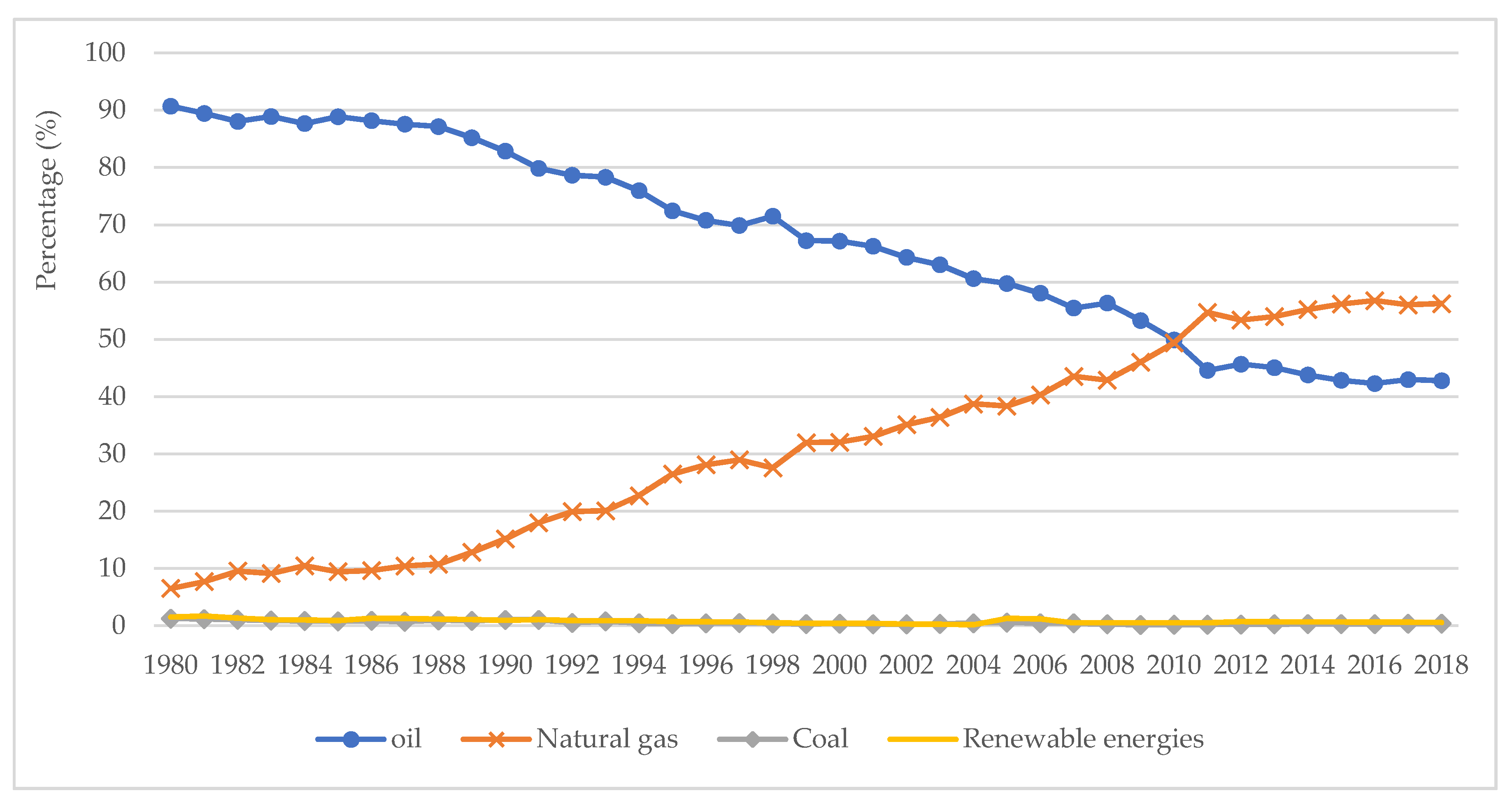
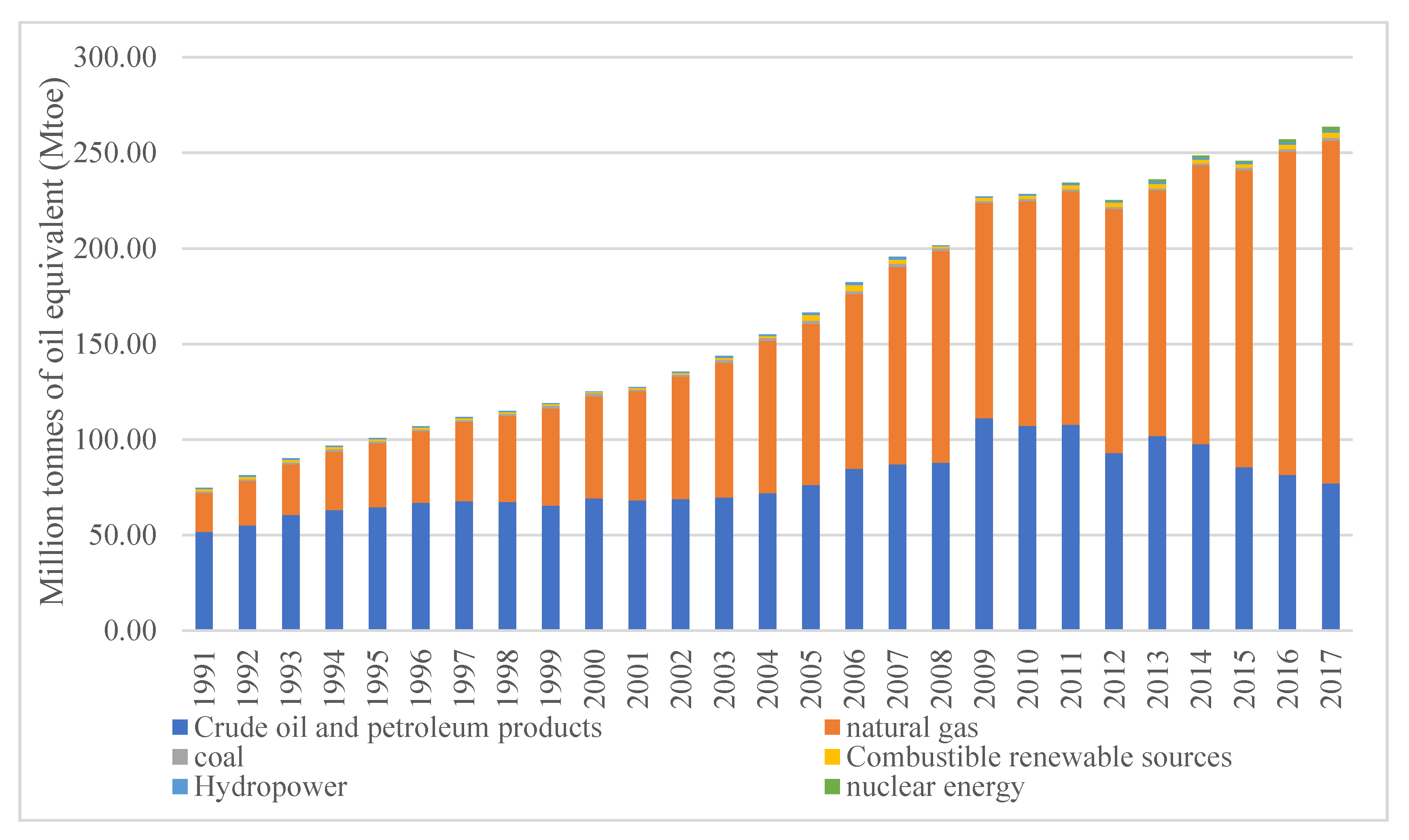
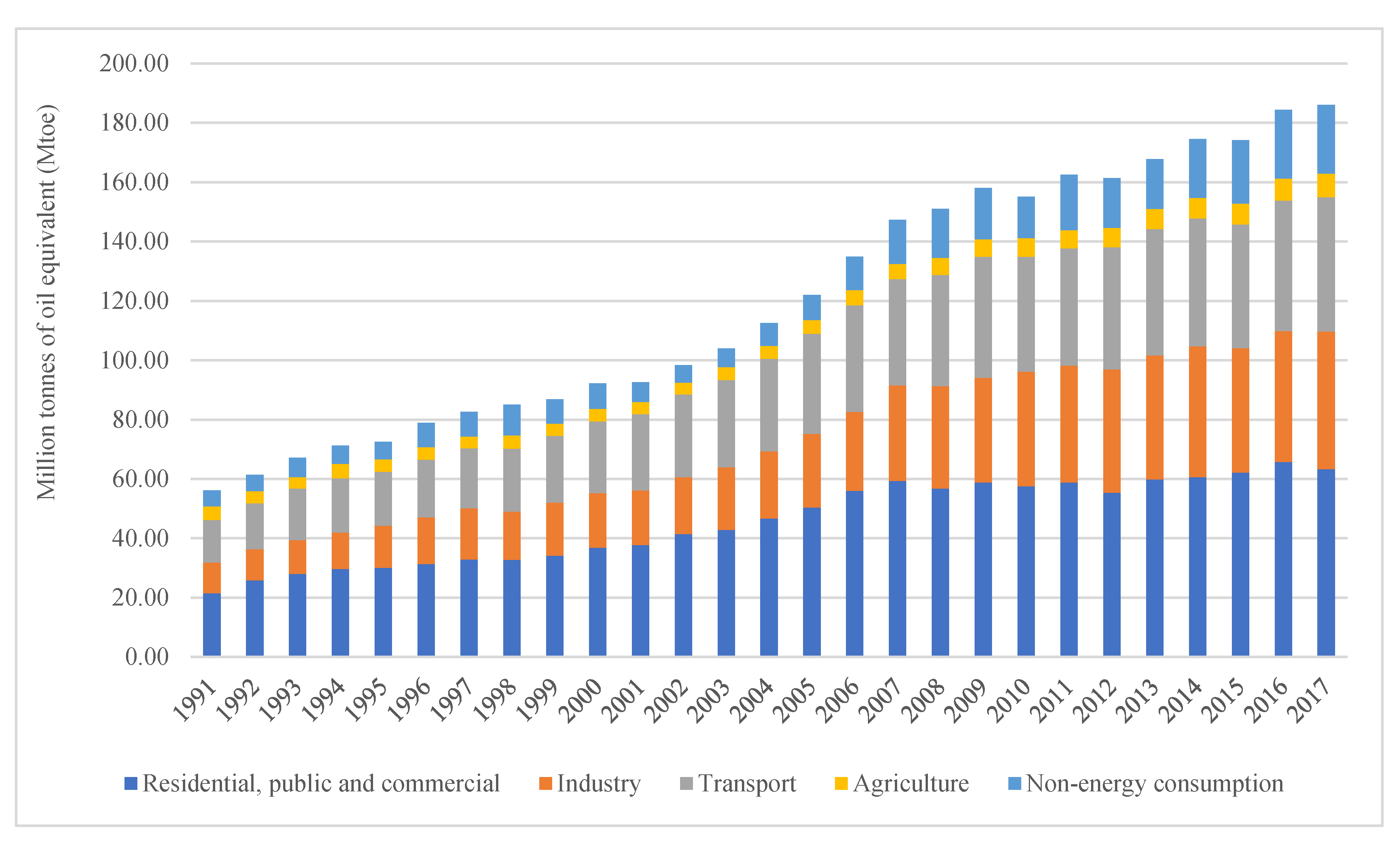
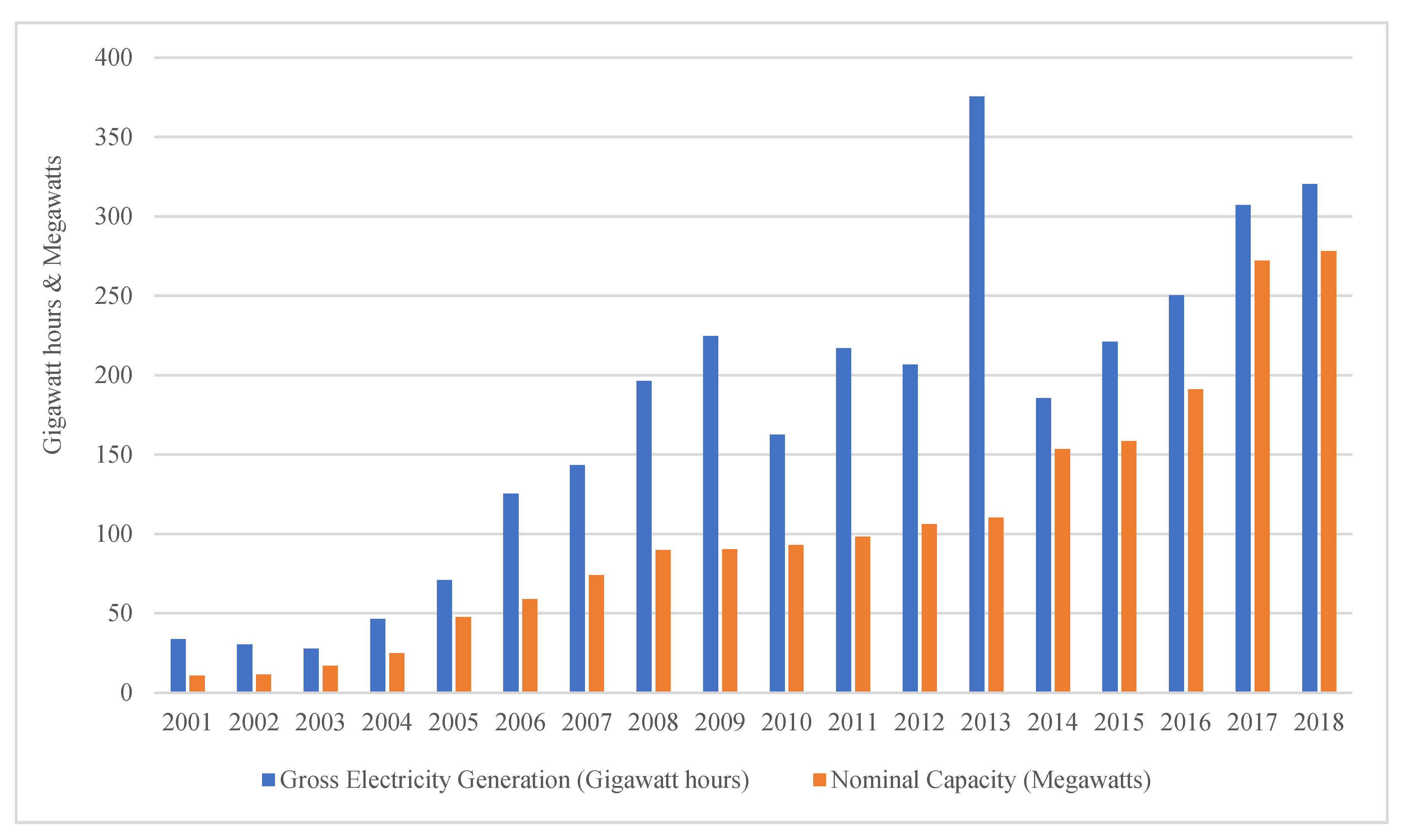
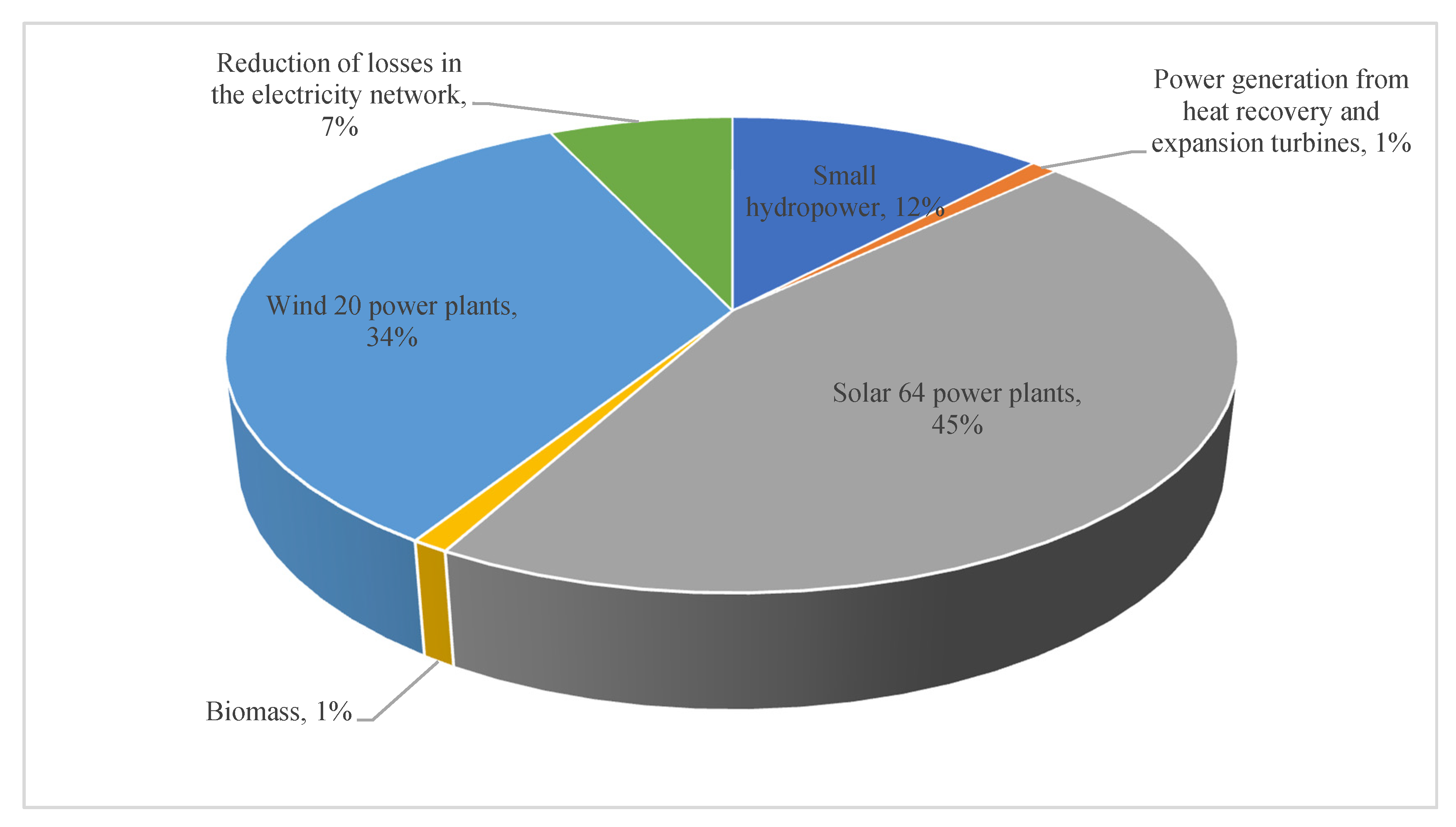
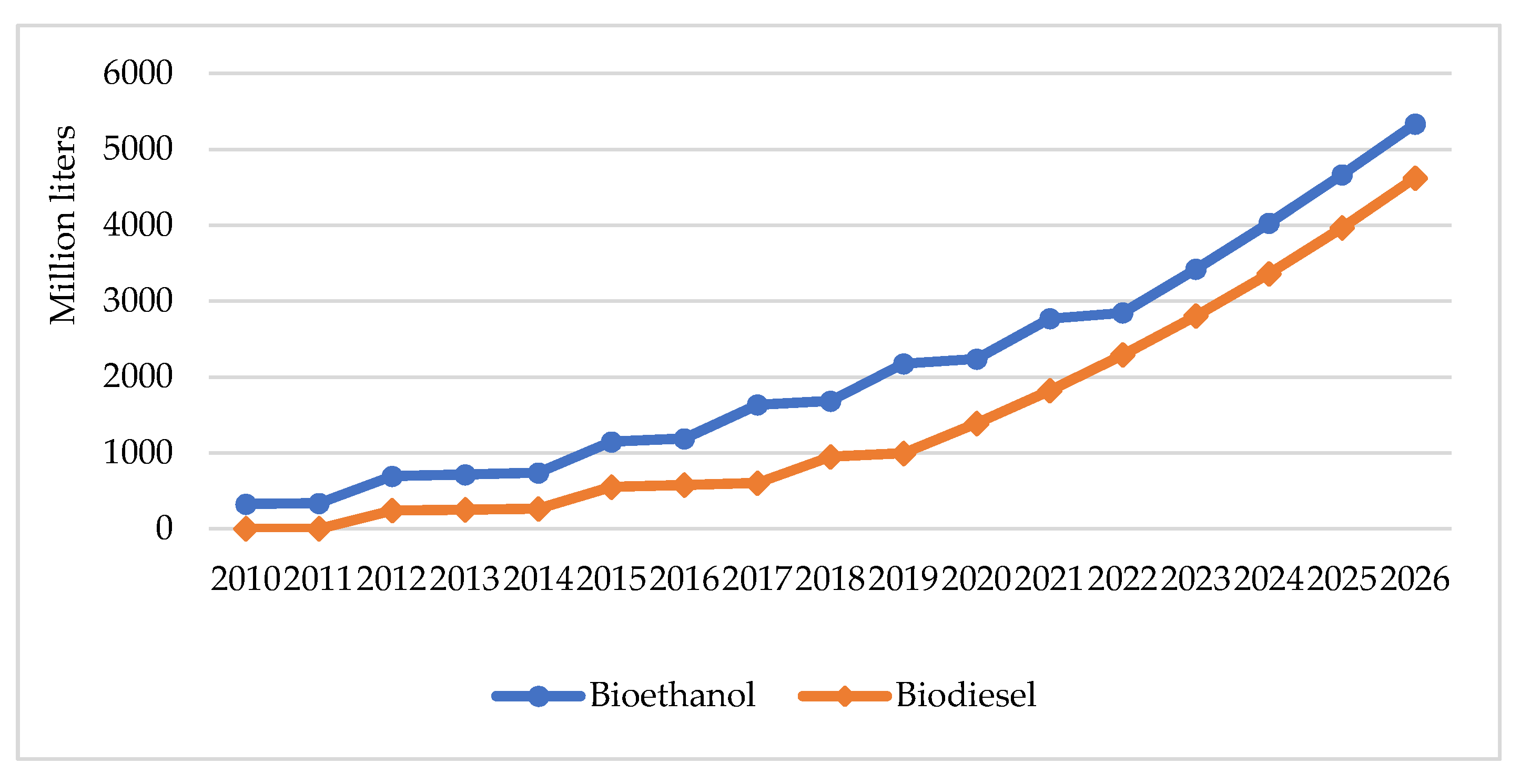
| Country/Region | Total Generation | Hydropower | Share (%) |
|---|---|---|---|
| Iran | 308.3 | 15.4 | 5 |
| Turkey | 274.4 | 67.2 | 24.5 |
| Pakistan | 114 | 36.6 | 32.1 |
| Europe | 4941.5 | 823.1 | 16.7 |
| Asia | 9796.9 | 1587.9 | 16.2 |
| Middle East | 1147.2 | 21.2 | 1.9 |
| United States of America | 4322 | 292.1 | 6.8 |
| World | 25,082 | 4170 | 16.6 |
| Renewable Energy | Potential (MW) |
|---|---|
| Hydropower | 26,000 |
| Solar energy | 86,198.2 |
| Wind energy | 18,000 |
| Biomass and biogas | 19.04 |
| Geothermal energy | 187 |
| Type of Power Plant | Province | Year of Operation | Capacity (MW) |
|---|---|---|---|
| Extraction of methane gas and construction of biogas power plant to generate electricity from municipal waste | Razavi Khorasan | 2009 | 0.6 |
| Fars | 2009 | 1.06 | |
| Tehran | 2014 | 1.9 | |
| Tehran | 2010 | 4 | |
| Tehran | 2014 | 3 | |
| Total | 10.56 | ||
| City | Ardabil | East Azerbaijan | West Azerbaijan | Fars | North Khorasan | Razavi Khorasan | South Khorasan | Gilan | Sistan and Baluchestan | Kerman | Bushehr | Hormozgan | Total Potential (Theory) | Total Economic Potential with 10% Capacity |
|---|---|---|---|---|---|---|---|---|---|---|---|---|---|---|
| No. of sites | 4 | 8 | 5 | 6 | 2 | 8 | 4 | 5 | 4 | 4 | 1 | 5 | ||
| Production (MW) | 10 | 25 | 15 | 30 | 1 | 65 | 2 | 15 | 10 | 1 | 3 | 25 | 208 | 20 |
| Production (Million Tons) | Waste (%) * | Waste (Million Tons) | Conversion Factor (Liters per Ton) * | Total Bioethanol (Billion Liters) | |
|---|---|---|---|---|---|
| Wheat | 13 | 50 | 6.5 | 400 | 2.6 |
| Sugarcane molasses | 0.3 | 100 | 0.3 | 300 | 0.09 |
| Rice | 3 | 25 | 0.75 | 400 | 0.3 |
| Barley | 3 | 20 | 0.6 | 350 | 0.21 |
| Corn | 10 | 30 | 3 | 360 | 1.08 |
| Potatoes | 5 | 30 | 1.5 | 110 | 0.165 |
| Dates | 1.3 | 40 | 0.52 | 360 | 0.1872 |
| Beet molasses | 0.25 | 100 | 0.25 | 300 | 0.075 |
| Grapes | 3 | 30 | 0.9 | 70 | 0.063 |
| Apple | 2.9 | 30 | 0.87 | 65 | 0.0566 |
| Total | 42.75 | 15.49 | 4.827 |
| Oilseeds | Area under Cultivation (Hectares) | Production (Tons) | Oil Content (%) * | Returns (Tons of Biodiesel per Year) |
|---|---|---|---|---|
| Cotton | 70,800 | 165,295 | 20 | 33,059 |
| Soy | 40,327 | 83,303 | 20 | 16,660.6 |
| Rapeseed | 191,251 | 329,843 | 40 | 131,937.2 |
| Sesame | 30,017 | 30,649 | 50 | 15,324.5 |
| Corn | 126,971 | 946,021 | 10 | 94,602.1 |
| Olive | 90,000 | 102,648 | 20 | 20,529.6 |
| Sunflower | 10,756 | 11,960 | 50 | 5980 |
| Safflower | 5239 | 4470 | 32 | 1430.4 |
| Almond | 200,000 | 142,000 | 55 | 78,100 |
| Walnut | 166,000 | 200,000 | 60 | 120,000 |
| Hazelnut | 27,000 | 15,000 | 55 | 8250 |
| Total | 958,361 | 2,031,189 | --- | 525,873.4 |
| Unrestricted Cointegration Rank Test (Trace) | ||||
|---|---|---|---|---|
| Hypothesized No. of CE(s) | Eigenvalue | Trace Statistic | 0.05 Critical Value | Prob. ** |
| None * | 0.501697 | 78.37974 | 69.81889 | 0.0088 |
| At most 1 | 0.300879 | 43.5524 | 47.85613 | 0.1197 |
| At most 2 | 0.257474 | 25.65581 | 29.79707 | 0.1393 |
| Unrestricted Cointegration Rank Test (Maximum Eigenvalue) | ||||
| Hypothesized No. of CE(s) | Eigenvalue | Max-Eigen Statistic | 0.05 Critical Value | Prob. ** |
| None * | 0.501697 | 34.82734 | 33.87687 | 0.0384 |
| At most 1 | 0.300879 | 17.8966 | 27.58434 | 0.5038 |
| At most 2 | 0.257474 | 14.88488 | 21.13162 | 0.297 |
| Null Hypothesis | F-Stat. [Prob.] | Null Hypothesis | F-Stat. [Prob.] |
|---|---|---|---|
| LGDP → LLF | 0.563 [0.573] | LNREN → LLF | 1.517 [0.230] |
| LLF → LGDP | 2.448 [0.097] *** | LLF → LNREN | 1.313 [0.279] |
| LGFKF → LGDP | 0.286 [0.753] | LREN → LLF | 0.909 [0.410] |
| LGDP → LGFKF | 1.303 [0.282] | LLF → LREN | 5.649 [0.007] * |
| LNREN → LGDP | 1.893 [0.162] | LNREN → LGFKF | 0.773 [0.468] |
| LGDP → LNREN | 2.664 [0.081] *** | LGFKF → LNREN | 0.588 [0.560] |
| LREN → LGDP | 0.183 [0.834] | LREN → LGFKF | 1.213 [0.307] |
| LGDP → LREN | 3.692 [0.033] ** | LGFKF → LREN | 3.829 [0.029] ** |
| LGFKF → LLF | 0.416 [0.662] | LREN → LNREN | 0.597 [0.555] |
| LLF → LGFKF | 0.816 [0.448] | LNREN → LREN | 3.664 [0.034] ** |
Publisher’s Note: MDPI stays neutral with regard to jurisdictional claims in published maps and institutional affiliations. |
© 2021 by the author. Licensee MDPI, Basel, Switzerland. This article is an open access article distributed under the terms and conditions of the Creative Commons Attribution (CC BY) license (https://creativecommons.org/licenses/by/4.0/).
Share and Cite
Solaymani, S. A Review on Energy and Renewable Energy Policies in Iran. Sustainability 2021, 13, 7328. https://doi.org/10.3390/su13137328
Solaymani S. A Review on Energy and Renewable Energy Policies in Iran. Sustainability. 2021; 13(13):7328. https://doi.org/10.3390/su13137328
Chicago/Turabian StyleSolaymani, Saeed. 2021. "A Review on Energy and Renewable Energy Policies in Iran" Sustainability 13, no. 13: 7328. https://doi.org/10.3390/su13137328
APA StyleSolaymani, S. (2021). A Review on Energy and Renewable Energy Policies in Iran. Sustainability, 13(13), 7328. https://doi.org/10.3390/su13137328






